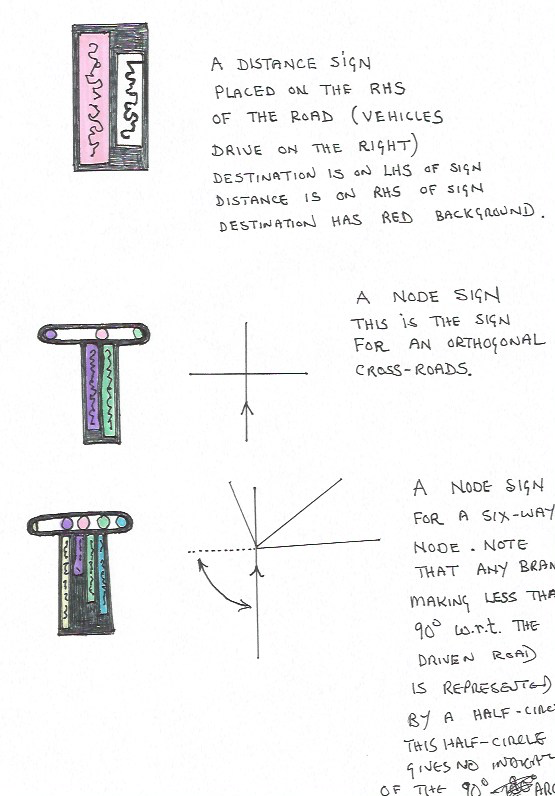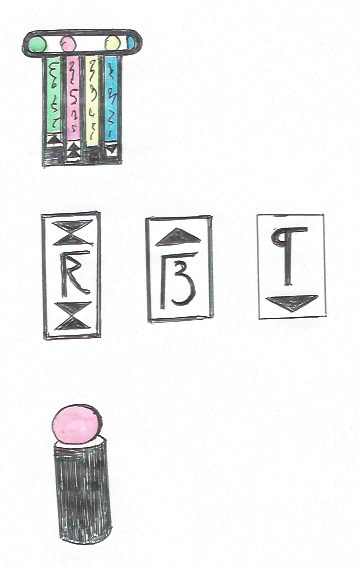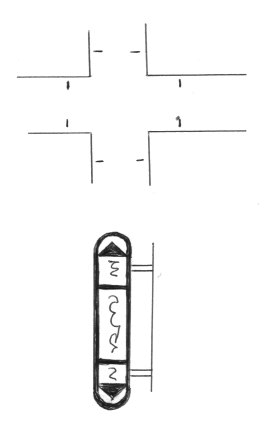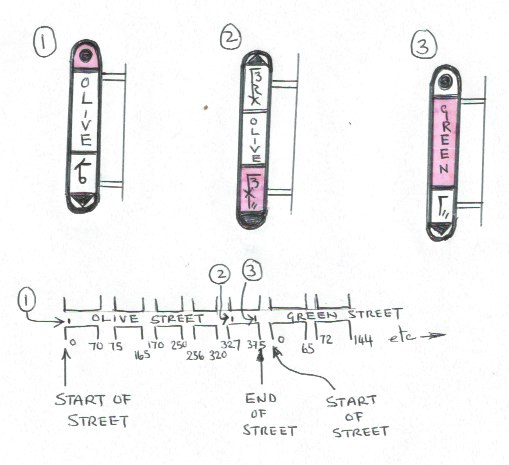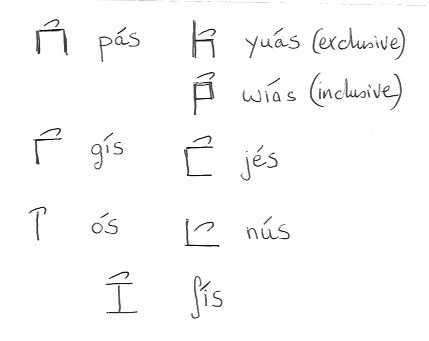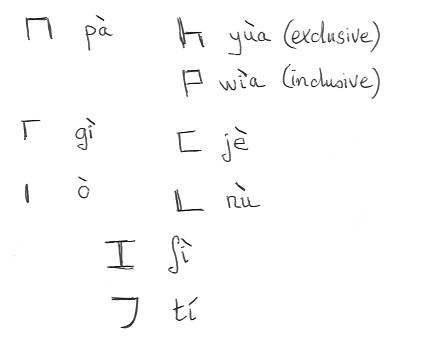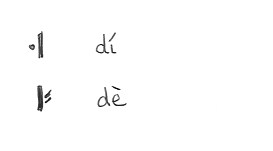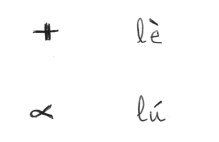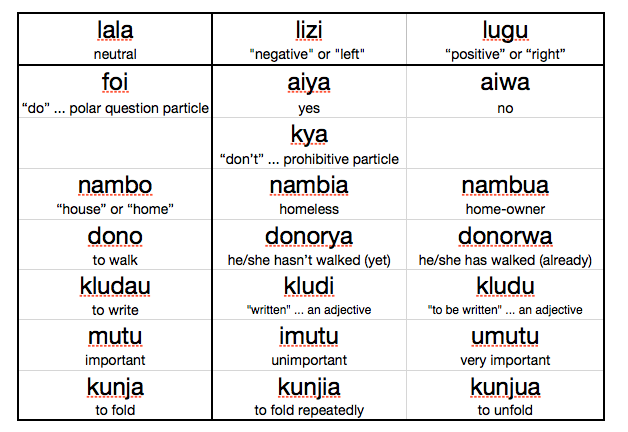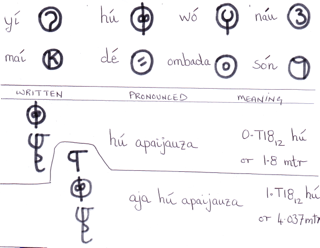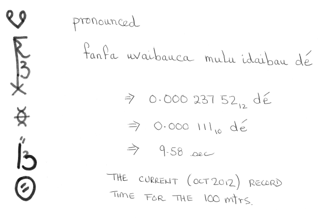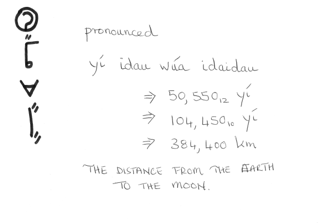Béu : Chapter 8: Difference between revisions
No edit summary |
|||
| Line 483: | Line 483: | ||
(For a super-parish there are 5 banner-rows with 7 banners each) | (For a super-parish there are 5 banner-rows with 7 banners each) | ||
.. | |||
==YīnYáng== | |||
'''liʒi''' and '''lugu''' can be considered the '''béu''' equivalents of Yin and Yang. | |||
----------- | |||
According to the Taoist tradition ... | |||
Yin is characterized as slow, soft, yielding, diffuse, cold, wet, and passive; and is associated with water, earth, the moon, femininity and nighttime. | |||
Yang, by contrast, is fast, hard, solid, focused, hot, dry, and aggressive; and is associated with fire, sky, the sun, masculinity and daytime. | |||
----------- | |||
Unfortunately the '''béu''' tradition is not so delightfully colourful. It is more workaday. | |||
It is basically the association in morphology of the sound '''i''' to the negative, and of '''u''' to the positive. | |||
Also there is a weaker association of '''i''' to the left and the past, and of '''u''' to the right and to the future. | |||
[[Image:TW_121.png]] | |||
'''wa''' or '''-ua''' or to a lesser extent '''u-''' are associated with positiveness. | |||
Also '''ya''' or '''-ia''' or to a lesser extent '''i-''' are associated with negativity. | |||
'''kludi''' and '''kludu''' might be expected to be swopped over ... | |||
'''-i''' is suffixed to indicate an action already done on an object and hence there IS NOT any action pending. ( IS NOT = negative ) | |||
'''-u''' is suffixed to indicate an action IS pending. ( IS = positive ) | |||
Also '''i''' is associated with past time and '''u''' is associated with future time (refer to the tense/aspect markers). | |||
In the '''béu''' mathematical tradition the primary axis is always horizontal. The origin is called the '''lala'''point. | |||
Negativity is to the left of this point and positiveness to the right. ( OK not so much difference from the way we do things in the West ) | |||
In calculus there is a strong preference to vary other dimensions with respect to time. | |||
===Units=== | |||
We have alread discussed numbers quite extensively. | |||
Now it is time to discuss '''béu''' units ('''jada'''). | |||
The unit of distance is the '''cwài''' (3.68 km) ... this is actually the radius of the earth divided by 1000<sub>12</sub>.... '''cwì''' = "distance" | |||
The unit of height is the '''hú''' (2.13 m) ... this is actually the '''yí''' divided by 1000<sub>12</sub>. | |||
The unit of weight is the '''wó''' (5.6 kg) ... this is actually (the weight of water in a cube with every side one '''hú''' long) divided by 1000<sub>12</sub>. | |||
The unit of area is the '''nàu''' (7,839 m<sup>2</sup>) ... this is actually (the area of a square with every side one '''hú''' long) multiplied by by 1000<sub>12</sub>. | |||
The unit of temperature is the '''mái''' (87 degrees Kelvin). This makes the temperature of the human body equal to 3 1/2 units. | |||
Also 3.0 '''mái''' is -12 degrees celsius and 4.0 '''mái''' is 75 degrees celsius. As the temperature of the air is nearly always between these two limits, when people discuss the weather, they normally drop the "3". | |||
The unit of time is the '''dé''' (24 hours). | |||
The unit of angle is the '''ombada''' (360 degrees). | |||
The unit of speed is the '''són''' (0.15333 km/hour) | |||
The above units are not normally written out in full. But they have special symbols as given below. | |||
[[Image:TW_98.png]] | |||
Now we must lay down how the unit word interacts with the number and with the 7 number "placeholders". This must be defined for both speech and notation. | |||
Well first of, if the number is such that it is next to '''omba''' (the decimal point), then '''omba''' is replaced with the units being used (in both recitation and in notation). For example '''hú''' is the unit used to measure height (it equals 2.237 mtr). My height (1.8 mtrs) would be pronounced '''hú apaijauza'''. A height of 4.037 mtrs would be pronounced as '''aja hú apaijauza'''. (see the chart above to see how this would be written down). | |||
Now if the number doesn't occur next to '''omba''' but on one side of a placeholder, then the unit is placed on the opposite side from the placeholder. | |||
[[Image:TW_99.png]] | |||
If the number occurs on both sides of a placeholder, then the unit is place at the very front. | |||
[[Image:TW_100.png]] | |||
Notice that in the notation the numbers must be contiguous with the placeholders. If there is a gap, then the sign for "h" must be inserted into the gap. Exactly as we insert zero's. But one different between our system and the '''béu''' system, is, in our system, zero's must be inserted to make the number contiguous with the decimal point (assuming we are using non-scientific notation), in the '''béu''' system "h"'s must be inserted to make the number contiguous with any placeholders that are used. | |||
The '''béu''' system may at first appear more complicated then the systems currently used. However it is all a matter of familiarity. It is just due to exposure to it for most of our lives that, for example, using hours, minutes and seconds seems so easy. With all equal amount of exposure, the '''béu''' system would be even easier. | |||
In our SI system, magnitude words are prefixed to the unit of measurement (for example "kilo" in kilometre). '''béu''' also has magnitude words (the placeholders) but they are inserted into the number itself (the '''béu''' system is better than the SI system because you get a different magnitude word every time your dynamic range passes 1728). Notationwise, it is a bit similar to the way we use comma's to separate a long number string into groups of three digits. | |||
.. | .. | ||
Revision as of 22:05, 17 December 2015
..... Signage
... Road
..
The above is what you pass through when you enter a town. There can be no "Welcome to Pleasantsville" written. It should just be a plane red colour on top. The name of the town on the sides.
On the opposite side of this sign, the red colour will be green. There will be nothing at all written anywhere on the other side ... next town ???
..
... Major Buildings
..
Quite similar to the node sign for roads is the sign giving directions in major buildings (such as airports, train stations etc.). However the position of the coloured circles does not show the angle that the joining road takes at the intersection. It shows the angle from the reader to the destination beacon. Actually there is a big black ring on the floor and it is assumed that the reader is within this ring. It is the angle from this ring to the destination beacon that is represented by the position of the coloured circles.
At the bottom of the below diagram, can be seen the destination beacon. It is a sphere about 50 cm in diameter. It is supported by a black pillar which is about 6 foot high. The beacon colour follows the colour of the circle in the sign. The beacon should be located in a clear (unobstructed) area maybe about 20 or 30 mtrs from the destination (for example toilets, information desk, screens displaying timetables, passport control etc. etc.). For course the destination should be clearly visible from near the beacon.
The signs at the middle of the above diagram are found near stairways and escalators. Upon stepping off a stairway the sign on the LHS should be clearly visible. This shows what floor you are on (ground floor is floor one by the way). The other two signs are positioned near the entrance to a stairway and tell you where the stairway is going.
..
... Streets
..
Above can be seen a street sign. These street signs are placed in from the corner, a distance equal to half the width of the street (measured building wall to building wall). They are well above head hight and offset from the wall by 60 % of their width. In the middle section is written the name of the street.
In the top section there is the distance along the street of the nearest corner. In the bottom section is the distance along the street of the next corner (measured in units of 2.13 mtrs ... houses do not have numbers as such ... they are all addressed as to how many mtrs they are along the street). Now the sign shown is what you see looking from the corner towards the street. What is written on the back side of the sign is exactly the same as you would see if you looked over directly behind you and saw the sign across the street (i.e. at an intersection you will see eight signs, but they come in pairs that are exactly the same).
One side of the street will have negative numbers. If you are walking away from the centre of town, then the negative numbered side will be on your left. If you are walking around the centre in an anti-clockwise direction, then the negative numbers will be on your left.
The start of the street is marked will the symbol for zero (a black dot), and no black triangle.
The end of the street is marked by that part of the sign having a red background (and no triangle).
To try and give you an idea of the system, I have drawn the diagram above. The signs 1, 2 and 3 are what you see on "olive street" at positions 1, 2 and 3.
What I have shown as pink should actually be red. I have done a bad drawing. Every instance of "olive" should be the exact same size. A lot of the signs will be different heights as no blank spaces are allowed inside a sign. Only one font and font size are allowed for every sign in a town.
One further point. If you are walking from the centre of town, and the street you are on is within 18 degrees of directly out from the centre, then every street name you see will have a green background (However the red background has precedence when green and red both apply).
No street can be longer than 1,872 units long (about 4 km)
..
..... Symbols
..
Words are not always written out in full. Certain common words have their own special symbol. For instance the ergative pronouns ...
And the non-ergative pronouns ...
The words "table" = pazba, "bracket" = gizgi, "interior wall" = ozdo and "chair" = yuzlu have probably got some relationship with the above symbols.
And the determiners ...
Note that dè looks similar to the sign for dùa ... similar but not exactly the same. The two slanting strokes meet the vertical stroke exactly halfway along for dè.
And the particles lè "and" and lú "or" ...
..
..... Some Musings
..
* WHAT ??? ... To get enough food ... is that it ??
it is not a complete answer ... but it is about 80% or 90% of the answer)
E) ... Other bits and pieces ... but really, they pale into insignificance compared to D).
However that fact should not condemn it to disregard. By arranging the beukia in such a way that people of "compassion" and "taste" always rise to the top of the organisation and and also by having a method that allows for continuous revision of every aspect of itself, béu should produce truths and ways that are very worthy of regard.
"béu" specifies certain "best practices" for many many aspects of life. These "best practices" encompass many varied aspects of life.
For example the manner in which the 5 yearly festivals should be celebrated, what screw shapes and sizes should be used, how a man should treat his wife and a woman her husband, the periods of fasting and dietary restrictions that each individual should undertake.
These are just some examples of these "best practices". Actually each of these "best practices" are given a level of importance. There are 3 of these levels ... "recommended", "highly recommended" and "an absolute must".
These "best practices" are set out in various books. Theses books are held to be "canonical" or holy. However these writings are not set in stone, and there are mechanisms where by these books are updated and also new books can be added to the "special books".
Some people consider these "special books" to constitute a religion that has no god. However other people follow these "best practices" as just "cool things to do" and fit them in to their lives under another over-reaching belief system, such as Christianity or Islam (in much the same way that the early Buddhist adherent were free either to forget the old hindu gods or to continue to venerate them).
béu place great importance upon education and lifelong learning. There is a core body of work that all béume must read. Also there are a great many “recommended works” that they are encouraged to study.
The most important “daily ritual” is 15 minutes given over to the study of these books..
béume are expected to show generosity, hospitality, and to constantly pursue of social justice and reform of poor institutions. They are discouraged from the excessive pursuit of luxury and status.
Rather … they believe that in order to be happy, you need …
1) A community of good friends
2) To be engaged in work that gives satisfaction (as part of this self-empoyment is look favourably on)
3) To spend a part of each day in contemplation (reading the holy books is believed engenders this contemplation) ... beume believe that the highest calling in life is to expand the body of knowledge that humanity possesses ( peugəŋgau) ... to accomplish addition or amendment to one of the treasure of books that are considered "cannonical" is to gain the greatest regard possible from fellow beume.
For the harmonious functioning of society as a whole, everybody should follow the rule …
1) What you do not wish for yourself, do not do to others
Probably the most detailed part of béu is beuba (the language of béu).
First some new words concerning béu ...
beuki = a person that follows béu and takes part in the community of béu
beume = a person that follows béu but follows in a private manner.*
beugan = all the people that follow béu plus all the paraphernalia of béu (i.e. buildings, flags, clothes, etc. etc.)
Note ... I will not use the term beuba from now on ... I shall simply say béu. This is sufficient since it is obvious that I am talking about the language. In a similar way, in a book about language you do not continuously come across the term "the English language" ... but rather "English".
The foundations of béu
Some questions and answers ...
Question ... What is béu ?
Answer ... béu is a way of life.
Question ... Where does béu come from ?
Answer ... Well béu was wilfully constructed here, down on earth, by humans. But actually béu is designed to evolve over time, so maybe it is better to say that béu is "being constructed", rather than "was constructed".
Question ... Why was béu constructed ?
Answer ... béu was constructed to fill a gap in the life of a man. Or perhaps it would be better to say ... béu was constructed to fill a gap in the lives of men.
Question ... What was the starting point in this construction ?
Answer ... The starting point for constructing béu was to ask two questions. Which were ....
What is a human being ?
What is the point of life ?
After some thought the first question was answered on three different levels …
A) ... A collection of genes.
B) ... A collection of urges ... to eat, to drink, to have sex, etc etc etc
C) ... A network of friends and family … loved-ones.
And after some further thought the answer to the second question was answered …
D) … To get enough food.*
béu is an attempt to build a "framework" for life. A framework that is compatible with the 4 answers given above. But why a framework, you might ask. Well it seems to be a psychological need. Because people are happier when they are told what they can and can not do, what goals are worth striving for and which are worthless. And also as part of this "framework" ... well people like "ritual", they like purposeful action without too much thought, they like the thought that they are part of something bigger than themselves, they like to feel meaning in their lives, they like to feel that they are part of a tradition that stretches back eons and eons. ( OK ... béu can not fulfil the last item ... or at least, not at the moment)
In short béu is a gigantic collection of meme's ... aesthetically pleasing and slotting together harmoniously with each other.
..
Three basic concepts ... angwa, honda and aska
At the centre of this body of work defining the "best practices" there are 3 important concepts.
angwa can best be translated as "harmony"
When used in relation to motion it can be translated as "grace" When used in relation to design it can be translated as "elegance" When used in relation to text it can be translated as "poetry"
angwai is an adjective meaning "graceful", "elegant" or "poetic"
angwa is considered getting the right balance between honda and aska
honda can best be translated as "order"
aska can best be translated as "chaos"
..
..... Mmmh
..
| I | pás | só pà | we | yúas | só yùa |
| we | wías | só wìa | |||
| you | gís | só gì | you | só jè | |
| he, she | ós | só ò | they | só nù | |
| it | ʃís | só ʃì | they | ʃís | só ʃì |
| Noun | Particle for a headless relative clause | ||
| kyù | occasion, time | kyù | "the time that", when |
| dá | place | dà | the place that |
| kài | sort, type | kai.a | "the type that", "as" |
| làu | amount | lau.a | the amount that |
..
The particle for an ergative headless relative clauses about things or persons is so.a ( maybe this can be considered a contraction of só ʃì à or só ò à ... by the way, these two forms are never found )
The particle for a non-ergative headless relative clauses about things is ʃi.a (this can definitely be considered a contraction of ʃì à ... the form ʃì à is never found although it is valid by the rules of grammar)
The particle for a non-ergative headless relative clauses about persons is o.a (this can definitely be considered a contraction of ò à ... the form ò à is never found although it is valid by the rules of grammar)
The head of headless relative clauses about people ... ò à or só ò à ... nù à or só nù à ... well actually any pronoun can be patterned like this.
..
The house cell
In the Christian religion, for the average adherent, the hour spent in church on Sunday represents the main obligation ... in terms of time anyway. Of course most Christians support their church financially and often their devotion results in some socialising with their fellows believers. This socializing usually has the aim of doing good-works but of course people enjoy socializing and these get-togethers often supply moral support with respect to personal problems and probably there is mutual re-enforcing of beliefs and a feeling of "solidarity" with respect to life's problems and the rest of the world in general.
The main time demand for a beuki is not sitting in a church listening to sermons but privately reading. This reading is done in a special room called a "cell". The volumes containing the body of knowledge that is considered "canonical" is read.
This reading is the most basic obligation however and most also go in for other "duties" such as dietary restrictions and prescribed daily excercise routines (to some extent at least). Many also volunteer time and money to the many activities which are proscribed by béu to promote personal happiness and social cohesion (these activities are actually designed to have the results (mentioned in the above paragraph) which seems like a chance by-product of certain Christian practices).
Other sections will go into detail about the duties touched on above. However this section is only about how the requirement to spend a certain time each day, reading the body of knowledge that béu considers "canonical" * affects the architecture of the typical béu followers place of residence.
..
..
The above shows the plan view of a "cell" : the room in which the reading of the "canonical" works is done. There is usually a cell in every family dwelling. It is a requirement that the cell is perfectly square and is windowless. Also the only lighting permitted is two oil lanterns fitted over either shoulder of the "reader" to cast light over the top of the lectern.
Behind the door is situated the bookcase that contain the "tomes" that constitute the béu canon. It is attached to the wall as opposed to standing on the floor. It can also be recessed into the wall.
Facing the door there is a large tapestry (a poster would also do). The image is usually of an awe-inspiring view of nature. However colourful fractals or geometric patterns are also quite common.
The rectangular object is a lectern. And behind the lectern is a comfy seat. And either side of the seat (above on the wall) are two lanterns.
As can been seen, the seat and the lectern are quite low. The chair is legless and the usual method is just to cross your legs on the floor just to the front of the seat.
It is common to excercise and bathe before doing your daily reading. Also many change into loose robes of a light blue colour, before entering the cell.
On the wall facing the lectern is "the shelf".
..
..
Below is shown a robe that is optionally put on before entering the cell to read. It is light blue ... quite similar to a robe that an Egyptian peasant would wear.
..
..
Below is shown the shelf attached to the wall facing the reader. About 4 or 5 feet of the ground. It is in the shape of an ellipse from which a third has been cut off from the depth, allowing it to be flush with the wall. In the middle is a small naked flame in a glass. Either side of the are two oblong vases with flowers. On the extremities (over the focuses) are two objects d'art. (the support or supports for the shelf are not shown)
..
..
Below is shown one of the lanterns. Obviously to prevent fire these ate placed in fairly substantial brackets connected to the wall.
..
..
Other items sometimes found in the cell ...
The books are meant to be read in 20 minute sittings and there is ofter an egg-times that counts out about 20 minutes. Usually about 6 inches high and kept on a special indentation on the lectern
A large glass goblet filled with marbles. They are numbered and come in different sizes. Used for keeping a record of what chapters have been read. All the marbles from one book would have the same size and colour. Perhaps inside the lectern is a large wooden tray with indentations. One indentation for every marble. When the goblet is empty and the tray is full, the course of study has been completed.
Large cards. A bit like playing cards but bigger and more solid. Each with intricate designs on it. Usually some sort of fancy box for them as well. These are for keeping a record of what chapters have been read.
Obviously if you have the cards you won't need the goblet and vice versa.
..
- At the present time, the body of work that is considered "canonical", consists of 15 volume (at the present time)s. However unlike other movements ... in béu, there is actually a mechanism for updating and improving these "proscribed books". The very opposite to every other religion. Every other religion has shown a strong instinct to hastily gather a body of script together and then to "set it in stone" ... well that is a by-product of our mental make-up. Hopefully the results of a more deliberate method will also be considered worthy of reverence ( or a little consideration at least :-) ).
..
The "canon"
Well there is the main volume of course ???
..
Then there is the 5 volumes containing the "5 main subjects".
History ... I have temporarily made Jared Diamonds book, "Guns, Germs and Steel" canonical (until the proper tome can be written of course).
Mathematics ...
Chemistry ... (maybe 30 % of the pages of this book will be given over to organic chemistry)
Physics ... Actually more comprising what I would call Engineering Science ( motion of bodies, forces and their direction within a bridge, etc. etc. )
The language of Béu ... actually a broader linguistic course
..
Then there is the 5 volumes containing the "5 minor subjects".
Human Physiology/Health ... maybe about 10 % of the pages of this book will be given over to how other animals do things (after first explaining how the human body does things of course)
The Civil Society which surrounds the beuki ... for example banking system, mortgages, local government, central government, tax, how the tax money is spent etc.etc.
Geology ...
Geography ... physical shape and how countries interconnect ... populations and population growth ... stage of development ( country by country or region by region )
Accounting/economics ...
..
We soon get on to "practical" subjects, such as metalwork, which is not really suited to be learnt solely from a book. So no more subjects needed ... better to restrict them to 10.
..
Then there is the x volumes concerning behaviour. (That is interpersonal relations)
General behaviour ... I have temporarily made Dale Carnegie's book, "How to win friends and influence people" canonical (until the proper tome can be written of course).
Husband <--> Wife ... I have temporarily made Nancy Van Pelt's book, "Highly Effective Marriage" canonical (until the proper tome can be written of course).
Employee <--> Employer ... There was a very good book by two guys with Dutch sounding names ... published at least 20 years ago ... I can not remember or find the book at the moment.
Child <--> Parent ... ???
..
Then there is a smallish book about First Aid
..
..
These canonical book are not set in stone however. There will be a mechanism for updating them.
Maybe this seems like a contradiction of terms ... a canonical body of work, yet mere mortals are allowed to change it. Well for some reason it is accepted by the beuki. Of course the scholars who update the work are very respected and there is a lot of conferring done before any update (also "any" bickering about what to update, is kept well out of the public eye).
The food complex
Many of the delights of life are found in the company of fellow human beings. Especially like-minded human beings. A lot of the customs of béu are designed especially to help people find that delight, to make them feel as if they are part of something bigger than any individual, to feel as if they are part of a community. The following is a tradition that has been designed with this in mind.
Every 3 seasons everybody is expected to get together with one other person and invite 2 strangers to dine (usually it will be to a home of one of the inviters). This is arranged by the local town hall. It is to facilitate meeting people that live near to you but that you do not know well. It is meant to be an enjoyable occasion for all involved. Only the 4 people should be present. Sometimes the hosts are siblings, sometimes a couple and sometimes friends. Usually the invitees do not know each other very well ... but sometimes they are a couple. Obviously some people are not into this sort of thing so they shouldn't be forced ... but they should be encouraged to be both hosts and guests.
The parish flags
béu country is divided into "parishes". These are rural communities of 10,000 -> 50,000 people (urban areas have are distinct from rural areas and have a very different administrative structure).
The parish boundaries follow geographical features, such as streams and ridges etc. However the shape of a parish approximates to a hexagon. In fact in a total featureless landscape it would be a hexagon.
The rim banners
Each parish has 6 banner-rows along its boundaries. A banner-row consists of 17 banners about 10 m apart. Each banner is made from a pole about the girth of an adults arm or leg. Each pole is about 7.5 m high and the top 5 m of the pole has an orange banner. The cloth of the banner is about 1/3 m wide. When about half the original cloth has been weathered away the cloth should be replaced, best to do an entire banner-row at on time. These banner-rows are normally placed in prominent positions. They can be anywhere along a boundary, but it isn't considered good to have the gap too small or too big between any neighbouring banner-rows.
In sparsely populated areas you get what is called a super-parish. They are around 10 times the size of a normal parish (but their population falls within the 10,000 -> 50,000 limit). These super-parishes have 2 barrier-rows per side(that is 12 in total), and each banner-row has 19 banners. All these banner dimensions are about 15% to 20% bigger than normal.
The outer banners
About 2/3 of the way out from the parish centre there are what are called the spoke banners arranged in banner-rows. There are 4 of these banner-rows and each has 11 banners. Again these are in prominent positions and/or well visible from roads. Again they should be quite spread out from each other.
Each of there banner-rows, instead of delineating the parish boundary, point towards the administrative centre of the parish, the kasʔau.
(For a super-parish there are 8 banner-rows with 13 banners each)
The inner banners
About 1/3 of the way out from the parish centre there are what are called the spoke banners arranged in banner-rows. There are 3 of these banner-rows and each has 5 banners. Below is what a banner looks like.
Again each of these banner-rows is pointing to the kasʔau.
(For a super-parish there are 5 banner-rows with 7 banners each)
..
YīnYáng
liʒi and lugu can be considered the béu equivalents of Yin and Yang.
According to the Taoist tradition ...
Yin is characterized as slow, soft, yielding, diffuse, cold, wet, and passive; and is associated with water, earth, the moon, femininity and nighttime.
Yang, by contrast, is fast, hard, solid, focused, hot, dry, and aggressive; and is associated with fire, sky, the sun, masculinity and daytime.
Unfortunately the béu tradition is not so delightfully colourful. It is more workaday.
It is basically the association in morphology of the sound i to the negative, and of u to the positive.
Also there is a weaker association of i to the left and the past, and of u to the right and to the future.
wa or -ua or to a lesser extent u- are associated with positiveness.
Also ya or -ia or to a lesser extent i- are associated with negativity.
kludi and kludu might be expected to be swopped over ...
-i is suffixed to indicate an action already done on an object and hence there IS NOT any action pending. ( IS NOT = negative )
-u is suffixed to indicate an action IS pending. ( IS = positive )
Also i is associated with past time and u is associated with future time (refer to the tense/aspect markers).
In the béu mathematical tradition the primary axis is always horizontal. The origin is called the lalapoint.
Negativity is to the left of this point and positiveness to the right. ( OK not so much difference from the way we do things in the West )
In calculus there is a strong preference to vary other dimensions with respect to time.
Units
We have alread discussed numbers quite extensively.
Now it is time to discuss béu units (jada).
The unit of distance is the cwài (3.68 km) ... this is actually the radius of the earth divided by 100012.... cwì = "distance"
The unit of height is the hú (2.13 m) ... this is actually the yí divided by 100012.
The unit of weight is the wó (5.6 kg) ... this is actually (the weight of water in a cube with every side one hú long) divided by 100012.
The unit of area is the nàu (7,839 m2) ... this is actually (the area of a square with every side one hú long) multiplied by by 100012.
The unit of temperature is the mái (87 degrees Kelvin). This makes the temperature of the human body equal to 3 1/2 units.
Also 3.0 mái is -12 degrees celsius and 4.0 mái is 75 degrees celsius. As the temperature of the air is nearly always between these two limits, when people discuss the weather, they normally drop the "3".
The unit of time is the dé (24 hours).
The unit of angle is the ombada (360 degrees).
The unit of speed is the són (0.15333 km/hour)
The above units are not normally written out in full. But they have special symbols as given below.
Now we must lay down how the unit word interacts with the number and with the 7 number "placeholders". This must be defined for both speech and notation.
Well first of, if the number is such that it is next to omba (the decimal point), then omba is replaced with the units being used (in both recitation and in notation). For example hú is the unit used to measure height (it equals 2.237 mtr). My height (1.8 mtrs) would be pronounced hú apaijauza. A height of 4.037 mtrs would be pronounced as aja hú apaijauza. (see the chart above to see how this would be written down).
Now if the number doesn't occur next to omba but on one side of a placeholder, then the unit is placed on the opposite side from the placeholder.
If the number occurs on both sides of a placeholder, then the unit is place at the very front.
Notice that in the notation the numbers must be contiguous with the placeholders. If there is a gap, then the sign for "h" must be inserted into the gap. Exactly as we insert zero's. But one different between our system and the béu system, is, in our system, zero's must be inserted to make the number contiguous with the decimal point (assuming we are using non-scientific notation), in the béu system "h"'s must be inserted to make the number contiguous with any placeholders that are used.
The béu system may at first appear more complicated then the systems currently used. However it is all a matter of familiarity. It is just due to exposure to it for most of our lives that, for example, using hours, minutes and seconds seems so easy. With all equal amount of exposure, the béu system would be even easier.
In our SI system, magnitude words are prefixed to the unit of measurement (for example "kilo" in kilometre). béu also has magnitude words (the placeholders) but they are inserted into the number itself (the béu system is better than the SI system because you get a different magnitude word every time your dynamic range passes 1728). Notationwise, it is a bit similar to the way we use comma's to separate a long number string into groups of three digits.
..
Index
- Introduction to Béu
- Béu : Chapter 1 : The Sounds
- Béu : Chapter 2 : The Noun
- Béu : Chapter 3 : The Verb
- Béu : Chapter 4 : Adjective
- Béu : Chapter 5 : Questions
- Béu : Chapter 6 : Derivations
- Béu : Chapter 7 : Way of Life 1
- Béu : Chapter 8 : Way of life 2
- Béu : Chapter 9 : Word Building
- Béu : Chapter 10 : Gerund Phrase
- Béu : Discarded Stuff
- A statistical explanation for the counter-factual/past-tense conflation in conditional sentences
